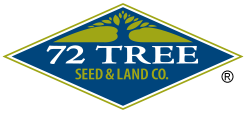Notice: Undefined variable: page in /home/vrxdg1855sn3/public_html/wp-content/themes/72tree/content.php on line 15
Notice: Trying to get property 'ID' of non-object in /home/vrxdg1855sn3/public_html/wp-content/themes/72tree/content.php on line 15
Tree Diseases on Bark
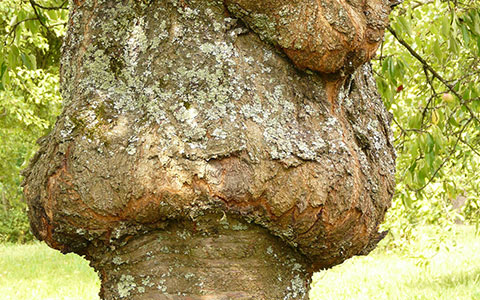
Prevent diseases on your tree’s bark from killing it. Knowing what type of disease is growing on or in your tree will help you take appropriate measures to treat it.
72tree.com gathered information on diseases that affect or appear on tree bark, how severe they are, and what actions are needed to prevent the disease from spreading.
Tree Bark Diseases
Tree bark completely covers a tree’s trunk, branches, stems, and twigs. It could be seen as a protective skin that repels insect infestations, shields against pathogens, and resists physical damage. Frequently, however, a stressed tree will likely develop one of the following:
Cankers on Trees
Cankers are dead areas of bark on a tree’s trunk or branch. Multiple factors can cause bark death, like damage caused by an impact, bacteria, or fungi. Pathogens such as bacteria or fungi are usually unable to penetrate healthy bark, but if the tree is stressed or the bark is damaged, infection is more likely. Consider the following types of cankers:
Wound Canker – These cankers, sometimes referred to as annual cankers, are most common at or near the base of a tree. They are typically caused by a lawnmower, vehicle, and/or maintenance equipment strikes or repeated abrasion.
Cankers resulting from impact wounds are severe threats that need to be prevented. Allowing conditions for these wounds to persist can result in the girdling and death of the tree.
Prevention: Create a safety zone using organic mulch or gravel around the tree.
Tip: Existing wounds should be carefully trimmed (without widening or deepening the wound), so the tree can properly seal the wound. Point out these wounds/repairs to your tree professional.
Perennial Canker or Cytospora Canker (Target-Shaped) – This canker is one of the more common diseases of shade and fruit trees. It is caused by one of several Cytospora fungi (Nectria, Strumella, Eutypella, etc.) and attacks multiple hosts, including:
• Apple (Malus domestica)
• Apricot (Prunus armeniaca)
• Ash (Fraxinus)
• Aspen (Populus tremuloides)
• Birch (Betula)
• Beeches (Fagus)
• Cherry (Prunus avium)
• Elm (Ulmus)
• Hickories (Carya)
• Maples (Acer)
• Peach (Prunus persica)
• Poplars (Populus)
• Walnuts (Juglans)
• Willow (Salix)
Cytospora infections can occur via bark wounds, at junctions of dead and live branches, or at poorly cut pruning wounds. The fungi slowly grow through bark during the tree’s dormancy (late fall and winter). Then, in the growing season, the host trees respond by compartmentalizing the affected areas. This alternating growth of the fungus and the tree forms a distinct elongated, target-like appearance.
Identification: These cankers will appear sunken on branches or trunks and present the following:
• Colors vary from off-brown to gray shades
• Black fungal structures (pycnidia) embedded in small bumps around the wound
• Brownish to orangish masses of spores being extruded from pycnidia
• Oozing sap and/or a wet appearance
Tip: These cankers slowly expand over time and can eventually girdle the branch or the whole tree (when located on the trunk). Ask a professional tree service to evaluate your tree and recommend a course of action.
Diffuse Canker – With these highly lethal cankers, necrosis spreads so quickly that the host can’t compartmentalize the area fast enough to stop its progression. The differences between these and other cankers are:
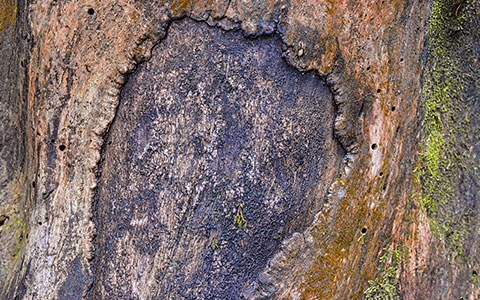
• No callus rings are formed, the affected area appears dark, sunken, and often moist
• Diffuse cankers continue expanding during the growing season
• When these cankers occur on a tree’s trunk, the tree will likely die
Some of the pathogens responsible for diffuse cankers are:
• Phytophthora dieback
• Cytospora canker
• Botryosphaeria canker
• Hypoxylon canker
• Chestnut blight
Identification: Diffuse cankers appear as sunken, dark areas similar to other cankers, but with no callus rings. It is common to see sap oozing from these cankers.
Note: Diffuse cankers move fast enough to completely girdle and kill their hosts in a single growing season.
Managing Pathogen-Driven Canker Diseases – As with nearly all tree problems, prevention is easier and less costly than treatment. Consider the following:
• Properly prune your tree (only in dry weather)
• Sanitize all pruning equipment with 10% bleach or 70% alcohol before and after each tree
• Remove and destroy any dead or infected material
• Prevent tree wounds (mechanical and environmental)
• Soil should be well-drained
• Improve tree health (water, fertilize, prune, and mulch)
• Apply a preventative chemical treatment to un-infected trees
Tip: Have your trees inspected annually by a professional tree service. Besides early detection of disease, you may identify other stressors that increase your tree’s susceptibility to developing cankers.
Mushrooms on Tree Bark
When you see mushrooms growing on a tree, be concerned. Mushrooms are the fruiting structures of fungi. For them to appear, the fungi must be well-developed and have caused extensive decay within the tree. Consider the following:
Mushrooms on a Tree Branch – Carefully prune the branch from the tree and destroy (burn) it. Avoid spreading pathogens from one tree to the next by sanitizing your equipment with 10% bleach or 70% alcohol before and after working on infected trees.
After removing all visibly affected limbs or branches, monitor your tree over the next growing season and have it thoroughly inspected for any other potential issues (decay-causing fungi can quickly spread throughout a tree).
Mushrooms on a Tree Trunk – Call a professional tree service as quickly as possible. Your tree’s trunk is likely suffering from extensive internal decay and needs removal.
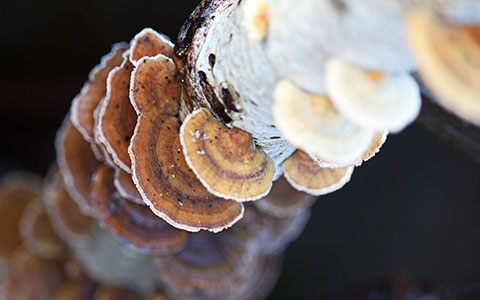
Mushrooms on a Tree’s Root Flare – Again, this is an urgent scenario. When mushrooms grow from the root flare, there is likely significant decay within the tree’s roots, potentially destabilizing the tree when winds and storms come through. The tree will likely require emergency removal.
Treatment: When dealing with mushrooms on your tree, you will be limited to removing affected limbs and branches. For this, prevention is easier and less costly than treatment. Consider the following:
• Properly prune your tree (3 cut method)
• Sanitize all pruning equipment with 10% bleach or 70% alcohol before and after each tree
• Remove and destroy (burn) any dead or infected material
• Prevent mechanical tree wounds
• Prepare your trees for severe weather events
• Soil should be well-drained to avoid root rot
• Improve tree health (water, fertilize, prune, and mulch)
• Apply a preventative chemical treatment to un-infected trees
Tip: Avoid disturbing these mushrooms. Trying to remove them can release billions of microscopic spores into the air, potentially spreading the disease to other trees, shrubs, and plants.
Tree Diseases
In this article, you discovered information about the diseases that affect and appear on tree bark, the damage they cause, and how to prevent them.
By taking swift action to treat or remove a diseased tree, you are protecting your property and surrounding trees.
When you ignore diseases appearing on tree bark, you risk the sudden death or destabilization of the tree and the expensive damages it can cause when it falls.
Sources:
uaex.edu/environment-nature/forestry/health/treecankers.pdf
extension.usu.edu/pests/ipm/notes_ag/fruit-cytospora
extension.colostate.edu/topic-areas/yard-garden/cytospora-canker-2-937/
Notice: Undefined variable: page in /home/vrxdg1855sn3/public_html/wp-content/themes/72tree/content.php on line 15
Notice: Trying to get property 'ID' of non-object in /home/vrxdg1855sn3/public_html/wp-content/themes/72tree/content.php on line 15
Tree Root Rot Causes, Symptoms, and Treatments
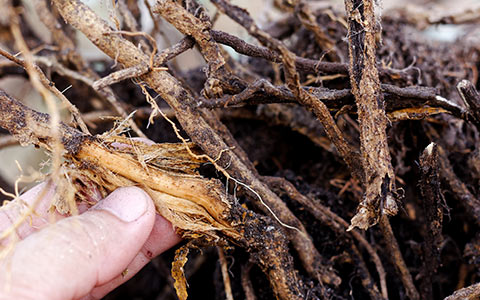
Don’t let root rot cause your trees to suddenly decline, die, and fall. Knowing how to identify root rot symptoms will help you save your tree or take action before it causes catastrophic property damages.
72tree.com gathered information on the causes of root rot in trees, how to recognize its symptoms, and what treatments you can use to stop or prevent it.
Tree Root Rot Causes
When root rot attacks a tree, the flow of water and nutrients from the roots to the crown is either impeded, or the invading pathogen is carried throughout the tree, killing its host. The following are several of those pathogens:
Rhizoctonia (this fungal pathogen adversely affects younger hosts, older trees are found to be more resistant)
Pythium (this fungus of the Pythiaceae family has 140 known species, most of which are now classified as parasites)
Rhododendron Root Rot (Phytophthora cactorum and Phytophthora cinnamomi were first thought to only survive in subtropical countries but is now known to thrive in cooler countries)
Fusarium (found worldwide, some of this pathogen’s species can adversely affect humans when infected crops are consumed)
Rosellinia necatrix (Dematophora necatrix, Hypoxylon necatrix, and Pleurographium necator, known as one of the most devastating plant fungal diseases, affecting several fruit tree and crop species)
Honey Fungi, Shoestring Root Rot, or Openky (Armillaria frequently occurs in hardwoods and pines)
Texas Root Rot (Phymatotrichopsis, Phymatotrichum, Cotton, or Ozonium root rot occurs more frequently in Mexico and the southwestern United States, causing sudden wilt and death)
Note: Fungal spores naturally occur and lie dormant in soil. These spores only begin reproducing when conditions support it. Such conditions include compacted soil, poorly-drained soil, and overwatering. As the fungi reproduce, tree roots provide a prime source of nutrients, allowing them to spread quickly.
Symptoms of Tree Root Rot
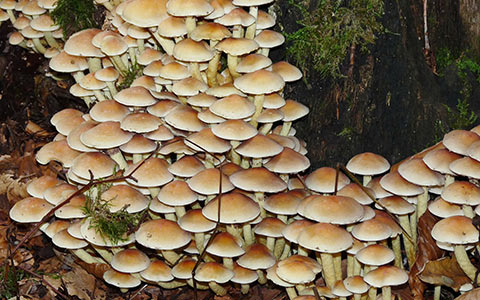
Most visible symptoms of root rot strikingly resemble the signs of an advanced pest infestation, making an accurate diagnosis more difficult. The most common, above ground, symptoms of root rot include:
• Gradual or sudden decline without a detectible reason
• Severely stunted or poor growth patterns
• Smaller, chlorotic leaves or needles (new growth)
• Wilted, yellowed, or browned leaves or needles
• Dieback
• Severe canopy thinning
• Stress crops (abnormally large amount of fruit/seeds)
• Fungal fruiting structures (mushrooms) found on the root flare or growing from surface roots
• Once in the xylem and phloem (cambium), cankers or sunken dead areas may appear on branches or the trunk of the host
A more accurate way to diagnose root rot is to dig to the roots to see if decay is present. Care should be taken when exposing roots to avoid inflicting further harm to the tree.
Note: Anthracnose is another group of fungal pathogens that cause similar above-ground tree damage but are not typically associated with root rot. You can find further information about anthracnose at 72tree.com/symptoms-of-anthracnose/
Tip: Hire an ISA certified arborist to inspect and accurately diagnose the cause(s) of the symptoms you have identified.
Tree Root Rot Treatment
Trees can sometimes be saved early on by pruning out infected roots. If a tree is in an advanced state of decline, the recommended way to control root rot diseases from spreading is to entirely remove it.
Chemical treatments that include propiconazole, chloropicrin, fosetyl-aluminum, or methyl bromide, among others, won’t completely cure or remove the disease but can reduce the infection level. These treatments are applied in and around the root plate of infected trees and especially in holes left after infected trees, and their stumps have been removed.
Note: The application of chemical treatments on your trees (for any reason) should be performed as directed on the product labeling and closely monitored by a certified arborist.
Root Rot Prevention for Trees
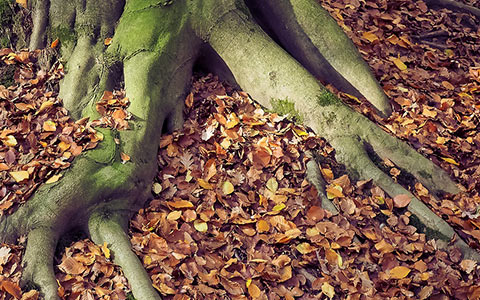
Trees have adapted over millennia to protect themselves against infection and illness. They are efficient at protecting themselves when healthy, and you can further assist them in resisting root rot by:
• Avoiding overwatering
• Ensuring proper water drainage by amending/enriching soil structure
• Preventing soil compaction on or around the root plate
• Protecting surface roots and trunks from mechanical and/or equipment damage
• Immediately addressing storm damage and/or soil erosion
• Removing unsalvageable trees from your property
• Planting disease-resistant species
Tip: You can also help trees fight fungal attacks by promoting their health. These are some of the things you can do to improve their health:
• Seasonal pruning
• Seasonally applying and refreshing organic mulch
• Deep watering (especially during drought conditions)
• Pre-growing season fertilization
• Annual tree inspections by a certified arborist
Note: The importance of annual tree inspections cannot be overstated. The ability to detect problems in their beginning stages offers more options to eliminate existing problems and take measures to prevent issues throughout the tree’s growing season.
Tree Root Rot
In this article, you discovered valuable information about the causes of tree root rot, recognizing its symptoms, and how to treat it or prevent it.
Taking swift action when root rot is suspected in your trees will increase your chances of saving them and preventing further infection.
Ignoring the signs of root rot will render your tree unsalvageable, invite other disease and infestation, and potentially cause catastrophic property damage when your tree destabilizes and falls.
Sources:
extension.umd.edu/hgic/topics/root-rots-trees-and-shrubs
ceventura.ucanr.edu/Com_Ag/Subtropical/Avocado_Handbook/Diseases/Root_rot,_how_to_spot_it_and_what_to_do_about_it/
forestpathology.org/root-diseases/
extension.psu.edu/rhizoctonia
hyg.ipm.illinois.edu/pastpest/199922c.html
Notice: Undefined variable: page in /home/vrxdg1855sn3/public_html/wp-content/themes/72tree/content.php on line 15
Notice: Trying to get property 'ID' of non-object in /home/vrxdg1855sn3/public_html/wp-content/themes/72tree/content.php on line 15
Metallic Wood-Boring Beetles Damaging Your Trees
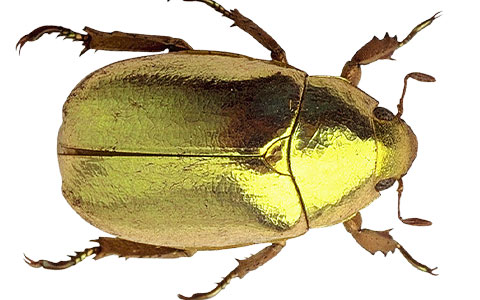
Prevent your trees from dying when metallic wood-boring beetles infest your area. By knowing how to identify these destructive beetles, you can take action to protect and treat your trees.
72tree.com assembled the following information on metallic wood-boring beetles (jewel beetles), the damage they cause to trees, how to protect your trees, and who to call when you identify their presence.
Metallic Wood-Boring Beetles (Buprestidae) – Jewel Beetles
Jewel beetles or metallic wood-boring beetles are members of the Buprestidae family of beetles, consisting of over 15,000 known species. The larvae of this immense beetle family are known as flathead borers. These beetles possess the following traits:
Appearance – Beetles have six legs and short antennae. Nearly all adult jewel beetles will have some metallic coloration on their body. In contrast, the brightest coloration typically appears under the wing covers (elytra) or on the insect’s underside.
Size – These beetles are generally cylindrical or elongated to oval, with lengths from .12 to 3.15 in; most species are under .80in.
Feeding Habits – Adult beetles of the Buprestidae family feed on their host tree’s foliage, causing little damage to the tree.
The larvae of these beetles burrow through the bark, roots, and stems of multiple species of trees and woody plants to reach the cambium (water and nutrient delivery system of the tree).
Some of the more well-known jewel beetles include:
•Emerald Ash Borer (Agrilus planipennis)
•Golden Buprestid (Buprestis aurulenta)
•Bronze Birch Borer (Agrilus anxius)
•Red-legged Buprestis (Buprestis rufipes)
•Flathead Apple Tree Borer (Chrysobothris femorata)
•Anthaxia (Anthaxia)
•Oak Splendor Beetle (Agrilus biguttatus)
•Eurythyrea austriaca (Linnaeus, 1767)
Note: Scientists at the Georgia Institute of Technology in Atlanta uncovered that jewel beetle color results from light-reflecting properties of the cells comprising their external skeletons. This research suggests that a jewel beetle’s color results from its physical structure (cell alignment) rather than pigment’s light-absorbing properties.
For important information about the emerald ash borer, read 72tree.com/emerald-ash-borer-tree-damage/
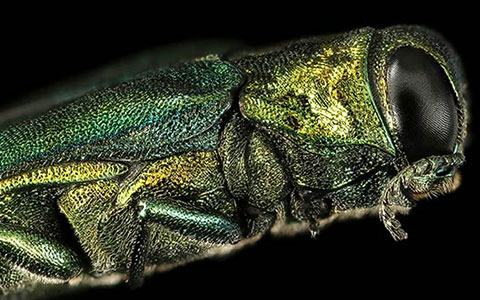
Metallic Wood-boring Beetle Life Cycle
As with most beetle species, their life cycle can be separated into 3 distinct phases, including:
Adult – In spring and summer, adult beetles emerge from their host and feed on its foliage while searching for a mate. Adult jewel beetles are typically short-lived, living only for a few weeks.
Egg – Females lay eggs in crevices in the bark of the same or a nearby tree.
Larva – After hatching, larvae bore into the host until reaching the nutrient-rich cambium of the host tree, where it feeds, grows, and pupates.
Most species have one generation per year or take multiple years to develop. However, some species may produce multiple generations per year.
Metallic Wood-Boring Beetle Infestation Identification
While visual confirmation of adult beetles is best, the following symptoms indicate that a metallic wood-boring beetle infestation is occurring:
•Partially consumed foliage (Leaf notches)
•Chlorosis of foliage in sections of the crown
•Dieback of foliage and stems
•Frass (sawdust) found on the bark from burrowing activities
•D-shaped exit holes in tree bark
•Bulging or vertical splits in the bark (over larval galleries)
•Suckers and water sprouts growing in the crown, on the trunk, and/or from the roots
•Woodpecker damage (woodpeckers hunt beetle larvae)
•Squirrel activity (some squirrel species feed on beetle larvae)
•Adults found in traps
Combined, the beetle’s different stages’ feeding habits will leave a tree with damaged, wilting foliage, and in rapid decline.
As larvae continue to feed, they channel through their host’s cambium layer in a zigzag or ribbon pattern. This feeding ultimately leads to a partial or total girdling of the host, resulting in hydraulic failure and death.
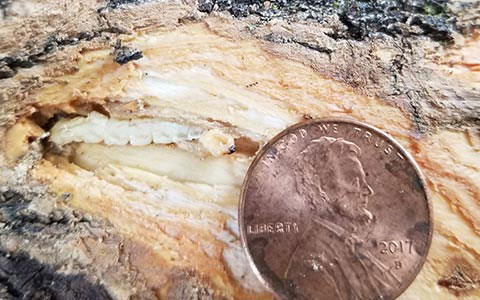
Affected Tree Species – Some tree species especially susceptible to wood-boring beetles in the Buprestidae family include:
•Pine (Pinus)
•Spruce (Picea)
•Fir (Abies)
•Hemlock (Tsuga canadensis)
•Ash (Fraxinus)
•Beech (Fagus)
•Hazelnut (Corylus)
•Apple (Malus domestica)
Generally, Buprestidae prefer attacking trees and woody plants in decline or dying. However, a number of the species will attack “green,” flourishing specimens. An example of this is the emerald ash borer (EAB), which has decimated the ash tree population in many parts of the US and continues on the move.
Note: Many wood-boring beetle species seek, attack, and infest specific tree families like the emerald ash borer that attacks those species within the ash family.
Metallic Wood-Boring Beetle (Buprestidae) Control and Prevention
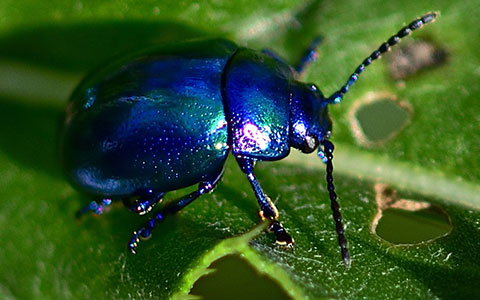
Due to their larvae’s hidden feeding activities, preventing a metallic wood-boring beetle infestation is not always possible. However, the following practices will help reduce the risk of an infestation:
•Select well-adapted species of trees not commonly attacked by wood borers in your area.
•Choose and prepare a suitable planting site to avoid tree stress, freeze damage, sunscald, windburn, and other stressors.
•Use proper watering and fertilization methods.
•Use proper seasonal pruning practices (winter/dormant season).
•Avoid mechanical injury to tree trunks from lawnmowers construction.
Your trees’ care includes the safe removal and destruction of infested, diseased, and dying trees from your property and surrounding areas.
Most of the time, wood-boring insects are secondary invaders (successfully attacking a tree already in decline). For a tree, the first line of defense against any infestation is to keep them healthy. Proper care of trees and woody plants discourages many borer pests. Good sap flow from healthy, vigorous trees, for example, defends the plant from damage by many borer pests.
If you have confirmed a boring insect infestation on or near your property, immediately contact an ISA certified arborist to evaluate your property’s risk and recommend a course of action.
Note: If you are inclined to use chemical treatments on your trees or as a ground soak, allow a professional to apply it. To chemically stop or prevent a boring insect infestation, such products must be applied correctly and at the right time.
Jewel Beetles (Buprestidae)
In this article, you discovered essential information about metallic wood-boring beetles, their appearance and life cycle, how to identify an infestation, and how to prevent or control these deadly beetles.
By taking swift action to prevent or control a jewel beetle infestation, you are helping all of the trees on and around your property.
When you allow a wood-boring beetle infestation to go unchecked, you can be responsible for devastating infestations spreading far beyond your property.
Sources:
texasinsects.tamu.edu/woodborer-metallic-woodboring-beetle/
extension2.missouri.edu/g7422
fs.usda.gov/Internet/FSE_DOCUMENTS/stelprdb5320268.pdf
nsf.gov/news/news_summ.jsp?cntn_id=115304
Notice: Undefined variable: page in /home/vrxdg1855sn3/public_html/wp-content/themes/72tree/content.php on line 15
Notice: Trying to get property 'ID' of non-object in /home/vrxdg1855sn3/public_html/wp-content/themes/72tree/content.php on line 15
How To Remove a Tree Stump Without a Grinder
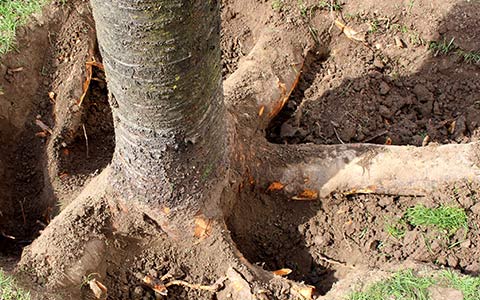
Avoid spending hundreds of dollars hiring a firm or renting a grinder to remove your tree stump. By knowing how to safely remove a tree stump, you can regain your landscape and save money.
72tree.com assembled the following information on methods for removing a tree stump without a grinder and crucial safety measures to observe.
Manual Tree Stump Removal
You can remove small and medium-sized stumps yourself with a few tools, some ingenuity, and muscle. When it comes to more massive stumps, you may want to get the help of a friend or relative to speed up the job and help with the heavy lifting.
Project Time: Manually removing your stump could take as little as 4 hours or up to 12, hours depending on the root ball’s number of roots and depth.
Removal Time: 4 to 12 hours
Tools, Protective Gear, and Costs:
•A sturdy and sharp shovel $15 to $35
•A mattock (similar to a pick-ax) $20 to $30
•An ax $25 to $45
•A steel 17Lb+ digging bar $30 to $40
•A bow saw $12 to $50
•Sturdy steel-toed boots $50 to $100
•Well-fitting work gloves $5 to $25
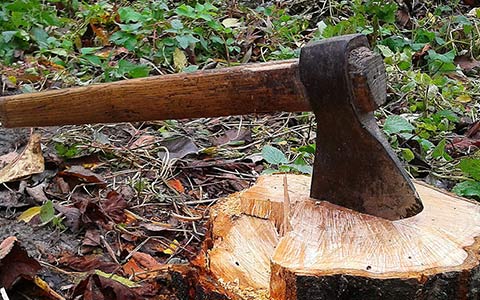
Your work gloves should snugly fit your hands. Loose gloves will move around, rub the skin, and cause blisters (defeating the purpose of wearing them).
Removing The Stump
1. Use the mattock, digging bar, and shovel to clear as much of the soil from around the stump and roots. Dig deep and wide to gain access to as many of the roots as possible. The larger the stump, the more soil you will need to remove.
2. Use the bow saw, mattock, and an ax to chop your way through the roots. When wielding an ax, take care to avoid over-chopping into the soil; this will quickly dull the blade.
3. As you cut roots away from the stump, cut them a second time to remove them from your work area.
4. Work your way around and under the root ball. Some species will grow a taproot, and this root will require some effort to sever. The more mature the tree, the more substantial the taproot will be. Dig deep and wide to gain as much access to this root as possible.
5. Once the stump is free, drag it out of the hole and fill in the void. (it will take more soil to fill in the hole than you removed from it).
Note: If you are not comfortable or knowledgeable using an ax, DO NOT use one. This tool can inflict severe harm if misused, use your mattock and/or bow saw in its place.
Tip: You can save a lot of time using a pressure washer to clear soil away from roots. Do this in sections and let the excess water soak into the ground. You can also dig a trench to guide water and soil away from your work area as you blast through the soil.
Chemical Tree Stump Removal
Just because there is no trunk or canopy, your stump may still be alive. Other trees in close proximity may be sharing water and sugars through their root systems, or your stump’s roots may have enough stored water and nutrients to attempt a comeback.
If multiple trees are connected by roots, the use of harsh chemicals on your stump may have adverse effects on the trees helping it to stay alive. Read more about killing tree stumps at 72tree.com/how-to-kill-stop-tree-stumps-growing-back/
You can remove medium and large-sized stumps chemically. While this process is much slower than manually removing the stump, it will save you from digging up your yard.
Project Time: Your stump’s height and diameter are determining factors for this project. It can be done in 1 hour and last as much as 4 hours.
Removal Time: 6 months to 1 year
Tools, Protective Gear, and Costs:
•A chainsaw (if you need to lower the height of the stump) $60 to $250
•A bow saw $12 to $50
•A drill and large boring bit (use the largest bit you can find) $70 to $200
•Plastic tarp $4 to $18
•Potassium-nitrate stump remover granules or high-nitrogen fertilizer $15 to $25
•Organic mulch $15 to $25 (free if you compost)
•Sturdy steel-toed boots (if using a chainsaw) $50 to $100
•Well-fitting work gloves $5 to $25
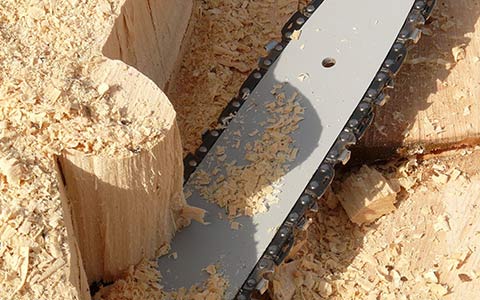
A note about the removal time: This process relies on the breaking down of organic matter and relies on warmth and moisture. In cooler climates, removal time may exceed 1 year while in warmer climates, this time may be less than 6 months.
Removing The Stump
1. Use your chainsaw or bow saw to lower the height of the stump. The lower to the ground, the more efficient this process will be.
2. Dill several deep holes in the stump. Use the widest bit available to you and drill the holes close together.
3. Fill each hole with water and your remover granules or fertilizer (don’t be shy, pour it in).
4. Use a soaker hose to saturate the soil surrounding the stump and apply a 3 to 6-inch layer of organic mulch over and around the stump.
5. Cover the stump and mulched area with a tarp to further retain the moisture.
6. Secure the tarp by staking it, covering it with a thick layer of organic mulch, and placing heavy objects (rocks and/or potted plants) on it.
7. Every 2 to 3 weeks, remove the tarp, repeat steps 3 and 4, and replace the tarp.
Under optimal conditions, the stump may soften within 3 to 4 months. It can then be broken up with an ax, retreated, and completely buried to further decay underground.
Note: Protect yourself with gloves, protective glasses, and clothing when using or dispersing chemicals. Wash your hands and any exposed body parts thoroughly after completing this job.
Tip: When having a tree removed, request that the tree be cut as close to the ground as possible. By doing this, you will save a lot of time when chemically removing your stump.
Caution: While other, more caustic agents like muriatic acid can be used to chemically remove a stump, they bring severe health hazards with them. Many acids do not require physical contact to cause harm, inhaling their vapors can cause significant respiratory damage. Avoid using such chemicals to preserve the health of your loved ones and surrounding wildlife.
Tree Stump Removal by Fire
You can remove medium and large-sized stumps by burning them. Before embarking on this method, verify that there are no municipal restrictions or forbiddance by HOA rules on burning out tree stumps.
Project Time: Depending on the freshness of your stump, this project can be done in 1 hour and last as much as 2 hours.
Removal Time: 1 day
Tools, Protective Gear, and Costs:
•A drill and large boring bit (use the largest bit you can find) $70 to $200
•A sturdy and sharp shovel $15 to $35
•Kerosine $2.70 to $3.30 per gallon (pricing varies with fuel market values)
The more time your tree stump has had to dry out, the more effective this method will be. However, stump removal by fire can be used at any time.
1. Start by digging a trench around your stump 4 to 6-inches deep and 10 to 12-inches wide. This will remove grass and debris that might ignite.
2. Drill several holes as wide and as deep as you can into the stump, the more, the better. Using a hammer and chisel, bore out a deep hole 3 to 4-inches wide in the center of the stump.
3. Pour kerosine into all of the holes and let the stump soak it up. Repeat this step several (3 to 4) times before lighting the stump on fire.
4. When you are ready to light the stump, apply kerosine once more. The larger, center hole should be wet with kerosene and filled with charcoal to intensify the heat. Ignite the stump from a safe distance.
5. Let the stump burn completely before disturbing it.
6. Anything left after this method should be easily broken apart and buried where the stump once was.
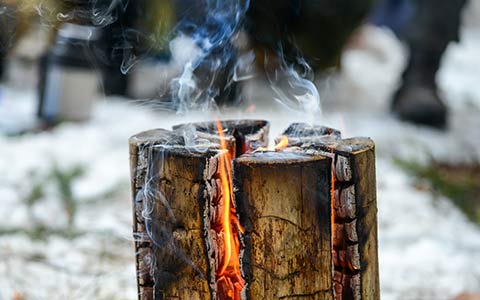
Tip: Keep a fire extinguisher and water hose close by when burning a stump. If winds pick up, embers may be blown to surrounding structures, use the hose to extinguish the embers.
Caution: Kerosine floats on water. If you must extinguish the fire, use a fire extinguisher on the stump. The use of water may carry lit kerosine spraying in all directions.
Tree Stump Removal
Along with the options presented in this article, come specific hazards that should be addressed when attempting to remove a tree stump. If, at any juncture, you feel that you cannot safely remove your tree stump, stop what you are doing, and call a professional tree service to remove the stump for you.
How To Remove a Tree Stump
In this article, you discovered multiple methods for removing a tree stump without using a stump grinder and crucial tips to speed up the job and keep you safe.
By following some simple instructions and properly using your tools, you can remove your tree stump without the cost or mess of using a stump grinder.
Improperly trying to remove a tree stump may result in catastrophic physical injuries leading to costly medical bills and health consequences.
Sources:
extension.sdstate.edu/how-remove-stump
extension.illinois.edu/blogs/rhonda-ferrees-ilriverhort/2014-06-20-removing-tree-stumps
warnell.uga.edu/sites/default/files/publications/Stump%20Removal%20pub_14-8.pdf
Notice: Undefined variable: page in /home/vrxdg1855sn3/public_html/wp-content/themes/72tree/content.php on line 15
Notice: Trying to get property 'ID' of non-object in /home/vrxdg1855sn3/public_html/wp-content/themes/72tree/content.php on line 15
How To Get Rid of Tree Fungi
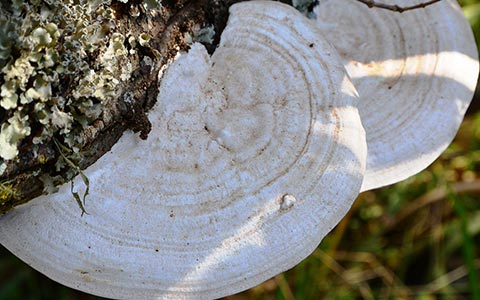
That fungus growing on your tree could kill it and turn it into an extreme hazard. By knowing how to deal with tree fungi, you can help your tree thrive for decades.
72tree.com gathered information on identifying harmful tree fungi, how to get rid of it, and what you can do to prevent it.
How To Treat Tree Fungus
Before you start dowsing your tree with fungicides and other chemical mixtures, you need to identify what type of fungus is growing on your tree and if it can be removed safely.
Mushroom Conks – If you have mushroom conks growing out of your tree trunk, it is a sign that the fungi at work have already penetrated the tree’s defenses and are decaying the heartwood of the tree.
For these mushroom conks to appear, there must be decaying wood within the tree to feed the fungus. This type of inner decay is known as heart rot.
When mushrooms grow from the root flare or in abundance on surface roots, you can be certain that the root system of the tree has been compromised and requires immediate attention.
Treatment: Do not try to remove mushroom conks from a tree, you may inadvertently release billions of spores that can infect surrounding trees and plants. Call a professional tree service to evaluate the extent of the damage to the tree and recommend a course of action.
Lichens – A lichen, or lichenized fungus, is two organisms functioning as one. Lichens comprise a fungus in a symbiotic relationship with an alga and typically appear as a flat rounded leafy structure attached to the bark of a tree.
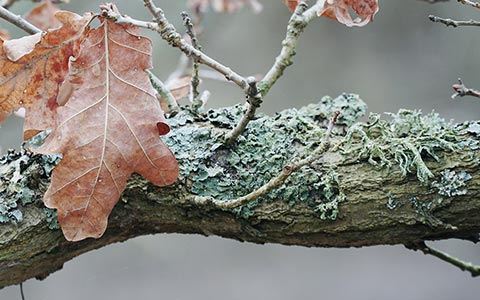
Lichens may appear harmful but are superficial, cosmetic eyesores at best. These organisms do not possess roots and rarely cause any damage to the organism they attach themselves to.
Treatment: If you wish, most lichen species can be eliminated from a tree with a mixture of 6 tablespoons of liquid copper sulfate mixed with 1 gallon of water applied during the tree’s dormant season. When applying this mixture, cover the lichen to the point of runoff.
Before using chemicals to control lichens, read the instructions printed on the label. By following the manufacturer’s recommended directions, you can increase the chemical’s effectiveness while preventing injury to the tree.
Fire Blight – Fire Blight can be caused by bacterial and/or fungal infections. It causes twigs and branches to appear water-soaked, then dark, and finally dry and cracked. Twigs and branches die from the terminal end and take on a burned appearance. Branches may bend or curl, commonly referred to as “shepherd’s crook.” As leaves and fruit die, they remain on the branches.
Treatment: Prune out infected branches (at least 8 inches below the damage) during the spring and summer. Do not prune while the branches are wet, as blight is highly transmissible via splashing water. Sterilize all pruning equipment before and after use on an infected tree.
Chemical control of blight is not always effective and should be used as a preventative measure in healthy trees.
Read more about fire blight prevention at 72tree.com/preventing-fire-blight-tree-disease/
Cankers – Cankers are dead, fungus-infected portions of tree bark on the branches or the trunk. They may appear as dark, open, seething wounds, or sunken, darkened, “wet” areas of bark. Most plant pathogens cannot penetrate tree bark directly. Still, they will colonize bark wounded by wildlife, poor maintenance, or mechanical injury.
Canker diseases can cause extensive damage to trees when they kill enough of the bark to girdle a branch or trunk. The fungus causing the canker is also capable of spreading throughout the tree, by way of the xylem and phloem, eventually appearing in other areas of the tree.
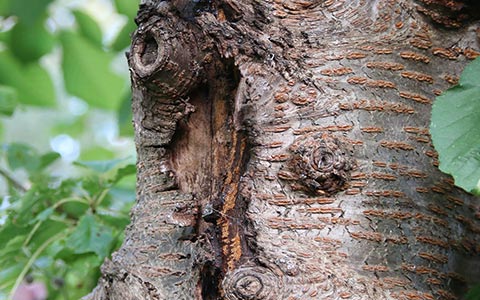
Treatment: For cankers found on twigs, and branches, prune the affected twig or branch from the tree. While normal pruning activities should be restricted to the tree’s dormant season, cankers are considered urgent. They can be pruned off the tree at any time of the year.
Note: Sterilize your pruning equipment before and after use on an infected tree. By doing so, you can prevent introducing another pathogen to the already sickened tree, and carrying the illness to another healthy tree.
For small cankers on tree trunks, tracing may help to reduce damage and slow its spread. Cut outside the cankered area into healthy bark, shaping the cut as an ellipse (this will allow the tree to compartmentalize the entire wound over time). Care should be taken to avoid infection of the fresh wound with canker or other pathogens.
For larger cankers on the trunk of a tree, call a professional tree service to evaluate the extent of the damage and recommend a course of action to either treat and save the tree or remove it.
Read more about heart rot and other diseases at 72tree.com/5-tree-pests-diseases-avoid-spring/
Tree Fungus Prevention
Trees have evolved over thousands of years to protect themselves against illness and infestations. They are highly efficient at protecting themselves when they are healthy and thriving. You can aide your tree by:
• Carefully apply fungicides during dry weather and before fungal growth
• Making sure pruning activities are done timely and with sterilized equipment
• Promoting its health throughout the growing season
• Using insecticides to prevent insect infestations
• Removing suckers from surface roots
• Preventing soil compaction on or around the root plate
• Immediately addressing storm damage
• Addressing or removing troubled trees from or around your property
Tip: You can help trees fight fungal attacks and heal themselves by promoting their health. These are some of the things you can do to improve the health of your tree:
• Seasonal Pruning
• Annual Tree Inspections
• Organic Mulch
• Deep Watering (without overwatering)
• Fertilization
• Protect Surface Roots and Trunk from Damage
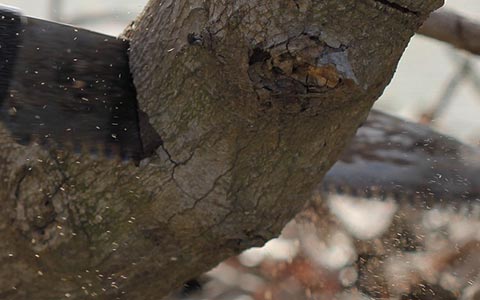
The importance of an annual tree inspection cannot be overstated. Detecting problems in their beginning stages helps you eliminate the existing problems and prevent potential issues throughout the growing season.
Killing Tree Fungus
In this article, you discovered the different fungi that can attack and harm your tree, how to treat it, and prevent it.
By taking swift action to remove fungus-infected parts of a tree and use measures to stop future infections, you are extending the life of your tree, and preventing it from becoming a threat to your property and wellbeing.
When you ignore the signs of fungal infections on your tree, you risk the tree dying and causing catastrophic damages when it eventually succumbs and falls.
Sources:
herbarium.usu.edu/fun-with-fungi/lichens
plantclinic.cornell.edu/factsheets/treecankers.pdf
vegcropshotline.org/article/10-useful-rules-for-fungicide-application/
extension.uga.edu/publications/detail.html?number=C871&title=Fireblight:%20Symptoms,%20Causes,%20and%20Treatment
Notice: Undefined variable: page in /home/vrxdg1855sn3/public_html/wp-content/themes/72tree/content.php on line 15
Notice: Trying to get property 'ID' of non-object in /home/vrxdg1855sn3/public_html/wp-content/themes/72tree/content.php on line 15
When Should I Cut Down A Tree on My Property?
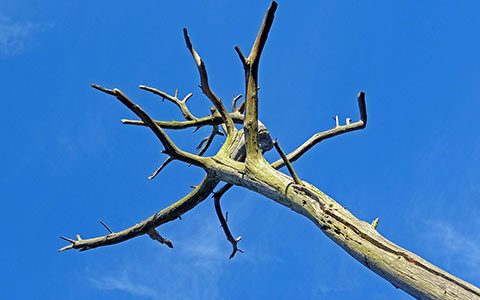
Does your tree look sick or like it’s going to fall? By knowing the signs of a hazardous tree on your property, you can take action to prevent catastrophic damages and losses.
72tree.com gathered information on the signs of a dead, dying, or dangerous tree, and whether or not it should be removed.
When Is Tree Removal Necessary?
You may need to remove your tree if it:
• Is dead or dying
• Is Rotting or hollow
• Has invasive or destructive roots
• Has been infested and poses a threat to surrounding trees
• Is diseased and could infect other trees or plants
• Poses an imminent threat to people, structures, or vehicles
Trees go through many phases as they mature. When any irregularities are detected, you should contact a professional tree service immediately. Have the tree professionally evaluated and make an informed decision on whether or not to remove the tree.
Is My Tree Dead or Dying?
The answer to that question is: Possibly. A deciduous tree may look dead, when in fact, it may only be dormant. Consider the following when evaluating your tree:
Deciduous Trees – A deciduous tree is one that loses its leaves in the fall and goes into a state of dormancy until the end of the winter season. These trees may look dead while in dormancy but are likely very much alive.
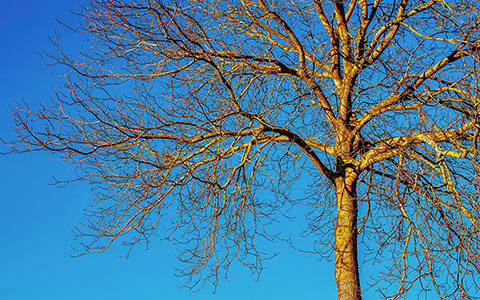
You can confirm this by performing a “scratch test” on a smaller branch or twig. If the twig is dead, it will be dry and brittle underneath the bark. A live one will have a shade of green and be moist under the bark.
Evergreen Trees – An evergreen tree maintains its foliage throughout the year. If you notice an excessive loss of foliage or the discoloration of a large portion of the tree, there may be root, sun, or wind damage.
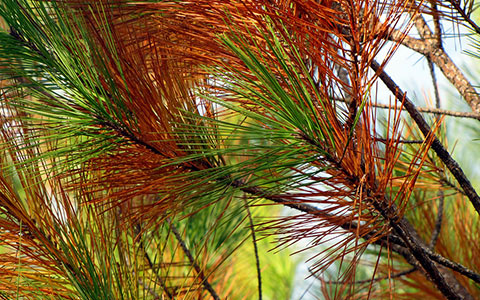
The following are signs of trouble for any tree and should be evaluated by a certified arborist immediately:
• The unusual or untimely loss of foliage
• Sections of the tree failing to leaf out in the spring
• Discoloration or wilting of a section of the tree crown
• New foliage is stunted, wilted, or discolored
• Mushroom conks are growing on the trunk or on surface roots
• Sprouts or suckers growing from the roots of the tree
• Entry or exit holes from boring insects
• Dead branches in the crown
• Sudden shedding of branches
• Your tree has begun to lean
• Neighboring trees are dying suddenly
• Mold or mildew has grown on a significant portion of the foliage
• There is significant damage to foliage from an insect infestation
• Your tree was struck by lightning
• Large portions of bark have been damaged or fallen off the trunk
• A severe storm has stripped your tree of foliage and damaged multiple branches
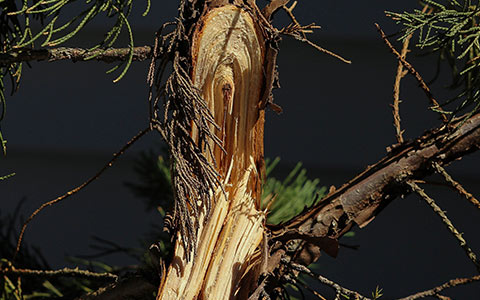
Through the life of a tree, it will face many health threats. In most cases, it can overcome those threats and continue thriving. However, when the tree is confronted by multiple threats, its health may decline, allowing some of those threats to damage it severely enough to kill it.
Many of the above signs can be mitigated or completely avoided when detected in their earliest stages. You can accomplish this by having an annual inspection performed on your tree(s) in late winter or early spring.
Read more about identifying tree diseases and trouble at 72tree.com/signs-diseased-tree-dieback-suckers-water-sprouts/
Removing Nuisance Trees from Your Property
Some tree species can become a tremendous nuisance as they mature and thrive. Some of the problems they may cause include:
• Interfering with power lines
• Branches overhanging your house, garage, or neighbor’s property
• Invasive roots breaking foundations, invading septic tanks, or buckling concrete
• Large roots growing along the ground surface
• The tree is self-pruning and begins to shed large limbs (eucalyptus trees do this frequently)
Invasive root systems like those of the aspen species can cause massive amounts of damage in a short amount of time. Read more about invasive root problems at 72tree.com/tree-roots-buckling-concrete-driveway/
In cases where a tree is near or on your property line, arguments and disputes may occur between neighbors. Before taking any action, you will need to determine ownership and/or responsibility of that tree. Read 72tree.com/who-is-responsible-overhanging-tree-branches/ to learn how this is determined.
Do I Need A Tree Removal Permit
Cities and municipalities across the country have tree ordinances in place to protect or preserve their trees. That said, there are cases in which dead trees or trees that pose an imminent threat of falling can be removed immediately and without a permit. However, you will likely be required to document the hazard and the need for removal fully. A certified arborist’s report, in some municipalities, may also be required.

You can hire our arborist, or search for an arborist or verify one’s credentials by visiting treesaregood.org/findanarborist/arboristsearch
Special Trees – Some tree species are vigorously protected in some municipalities, and their removal, for any reason without permission, may result in steep fines, recompense, and even planting new trees of the same or predetermined species, as defined by the tree ordinance. These reasons may include:
• Historical significance
• Age
• Size
• Rare or protected species
• Wildlife refuge
• Trees with a specific diameter at breast height (DBH)
Whenever you have a tree that needs to be removed (for any reason), consult your city’s codes and ordinances to determine whether you need a permit or not. The following may help as well:
• Visit your city’s website and search for tree removal permit information
• Call your city’s arborist or Forestry department
• Hire a professional tree service that can acquire the appropriate permits and do the job.
When it comes to trees, medium and large trees should always be handled by professionals. If you try to cut such a tree down without the proper knowledge and equipment, you may be placing your property and your life in jeopardy.
Removing Trees from Your Property
In this article, you discovered how to determine when a tree is dead, dying, has become a hazard, and if it should be removed.
By taking action when you detect a tree illness, infestation, or damage, you are preserving the safety of your property.
When you delay taking care of sick or wounded trees, you are leaving an open invitation for catastrophic events that can destroy your property and threaten the well-being of you and your loved ones.
Sources:
extension.umd.edu/hgic/topics/how-do-you-decide-when-remove-tree
extension.umn.edu/solve-problem/plant-diseases#tree-and-shrub-diseases-1872363
entomology.ca.uky.edu/ent43
myminnesotawoods.umn.edu/wp-content/uploads/2014/06/MNLawTrees-NuisanceTrees.pdf
Notice: Undefined variable: page in /home/vrxdg1855sn3/public_html/wp-content/themes/72tree/content.php on line 15
Notice: Trying to get property 'ID' of non-object in /home/vrxdg1855sn3/public_html/wp-content/themes/72tree/content.php on line 15
How To Kill and Stop Tree Stumps from Growing Back
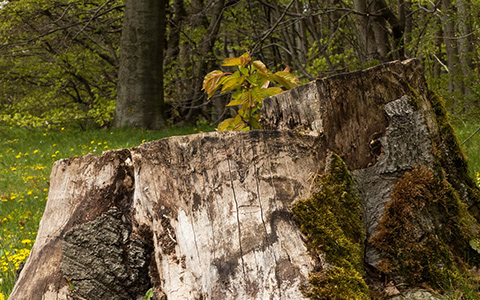
Is the tree you cut down trying to grow back from the stump? Many times, when trees get cut down, the stump and roots will continue to send out new growth. Knowing why they do this and what to do with it once the tree is gone can save you loads of time, effort, and money.
72tree.com assembled the following information on why trees grow back after being cut down, how to kill a tree stump, and remove it.
Do Trees Grow Back After Being Cut Down
Yes, they can. That’s why it’s essential to be knowledgeable about tree growth when you need to remove one permanently.
Cut trees with enough stored sugars and nutrients in their roots can produce sprouts from the roots and trunk as a measure of survival and reproduction. The following species will commonly sprout after being cut down:
• Poplars
• Maples
• Lindens
• Boxelder
• Red Oak
• Willows
• Beech
• Ash
When this survival mechanism is triggered, single, or multiple sprouts may appear. If left unabated, these sprouts will grow into trees without having grown a stable root plate, and likely pose a much more immense falling hazard than the original tree.
How to Stop Tree Stumps and Roots from Sprouting
Before you select a method to kill or remove a tree stump, evaluate the potential impact on the environment and immediate surroundings. The following are methods to eliminate tree stumps from sprouting:
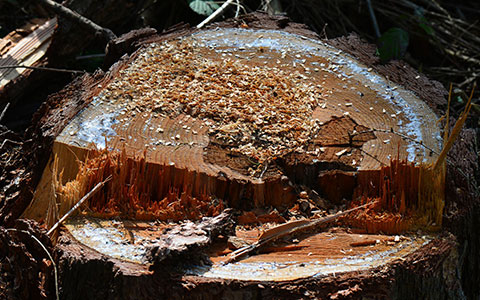
Use Fertilizer for Rapid Decay – To accelerate the decaying process of the stump, do the following:
• Cut the stump to soil level
• Drill half-inch to inch-wide holes six to eight inches deep into the stump and aerial roots
• Apply a slow-release fertilizer to the holes and over the stump
• Cover and “mound” with soil
With little to no impact on the environment, this method is highly effective but takes several months to decompose the stump fully.
Note: In this and the following methods, areal roots are the large protruding “anchor” roots at the base of the stump.
Using Epsom or Rock Salt to Kill It – This process is one of the more economical, but takes several months to kill the stump. Apply this method by:
• Acquiring enough Epsom or rock salt to fill several deep holes and cavities in the stump
• Drill half-inch to inch-wide holes six to eight inches deep into the stump and aerial roots
• Pack the holes and any cavities with salt
• Use hot wax or another water-proof sealant to seal the holes and cover the cavities
• Secure a dark plastic tarp or trash bag over and around the stump to keep rain and sunlight out
In six to ten weeks, your tree stump should be dead and breaking apart.
Tip: While table salt will produce similar results, it is very harmful to the soil in the vicinity of the stump. Use only 100% Epsom or rock salt with no added ingredients.
Cover The Stump To Kill It – You can slowly kill your tree stump with this method, and it’s free.
• Secure a dark plastic tarp or trash bag over and around the stump to keep rain and sunlight out
Without adding any chemicals or salt, this method will take up to six months for the stump to die and start to decay.
While the tree is covered, there should be no growth. However, if sprouts do appear while the stump is still alive, cut them off.
Burn The Stump – Burning the stump is an effective way to remove it after it has died. The following steps will help you safely burn and remove your tree stump:
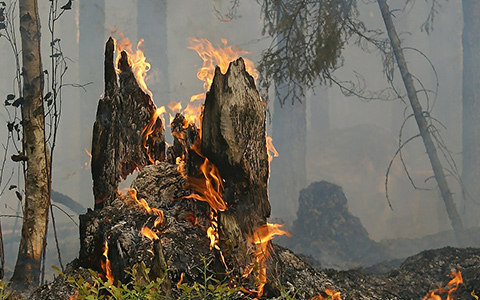
• Drill several half-inch to inch-wide holes six to eight inches deep into the stump and aerial roots. The deeper you can drill into the stump will ensure that it burns to the roots.
• Pour enough kerosene into the holes to thoroughly saturate the stump.
• Build a fire on top of the stump by placing scrap wood, twigs, and small logs on it. As the fire burns down, add more wood as necessary to keep the fire ablaze.
• When the stump has burned away, remove the ashes and replace them with soil.
As with any controlled burn, never leave it unattended. Keep a hose or fire extinguisher on hand in case the fire gets out of hand or begins to spread.
NOTE: Before using this method, consult your municipal ordinances to ensure that your controlled burn is legal, for more information call 411.
Tip: Turn the stump burning into a “bonfire” and invite friends and family over for an outside gathering.
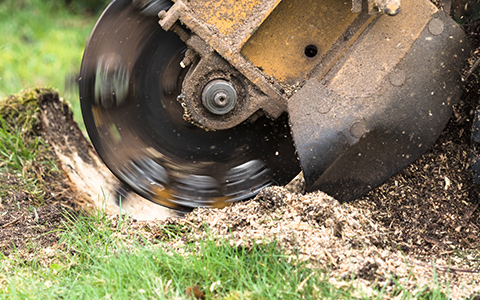
Grind The Stump – Grinding the stump allows you to chop it up and remove it immediately. This method requires protective clothing and equipment and some knowledge of machinery operation and safety. The following steps will help you safely remove your tree stump:
• Use a chainsaw to cut the stump as close to the ground as possible, leaving a level surface
• Grind the stump and any areal roots until fully ground up
• Remove the wood chips (use them for mulch or discard them)
• Fill the hole with fresh soil
Keep children and pets at a safe distance while the stump grinder is in use.
Note: Before operating this or any other machinery, refer to the operating manual to ensure its proper and safe use. There may be safety features that you are not aware of on the machine.
Call A Professional Tree Service – Take all of the stress, equipment, time, and chemicals out of the process by calling a professional tree service to come out and remove your tree stump. They have specialized equipment and experience to remove your tree stump quickly and safely.
Stop Your Tree Stump from Growing Back
In this article, you discovered why trees continue sending up sprouts after being cut down, how to kill a tree stump, and how to completely remove one.
By killing and removing your tree stump, you are preventing sprouts from growing and creating a hazard to surrounding structures and people.
Allowing a tree to re-grow in this manner is significantly dangerous. These new trees grow without establishing a firm root plate and may topple as they increase in size without warning.
Sources:
umass.edu/urbantree/factsheets/26killastump.html
ucanr.edu/blogs/blogcore/postdetail.cfm?postnum=20662
warnell.uga.edu/sites/default/files/publications/Stump%20Removal%20pub_14-8.pdf
Notice: Undefined variable: page in /home/vrxdg1855sn3/public_html/wp-content/themes/72tree/content.php on line 15
Notice: Trying to get property 'ID' of non-object in /home/vrxdg1855sn3/public_html/wp-content/themes/72tree/content.php on line 15
Common Maple Tree Diseases, Symptoms, Treatment, and Prevention
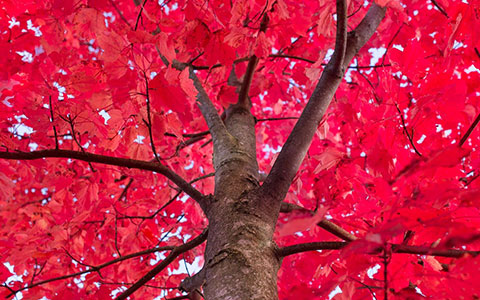
Stop your maple tree from needlessly dying. If caught in time, diseases that attack maples can be treated with success.
72tree.com of Alpharetta Ga, assembled the following list of diseases that affect maple trees, how to identify, treat, and prevent them.
Why do My Maple Tree Leaves Have Spots?
One of the easiest ways to detect maple tree diseases is through irregularities in shape or size, spots, and/or blemishes on the tree’s foliage.
The following diseases may cause spots to appear on your maple tree’s foliage:
Leaf Spot (Phyllosticta minima) – This fungal infection causes round spots about a quarter of an inch in diameter to appear on leaves. These spots will have a pronounced purple border and blackish dots in the center of the spot (fungal fruiting structures).
Treatment: Before fall, prune dead twigs, stems, and branches. Collect all clippings and destroy them (burning them is highly recommended) to prevent the spread of the fungus.
Have the tree evaluated to determine the extent of the infection and whether further action like using fungicides should be taken to protect your tree and surrounding landscape.
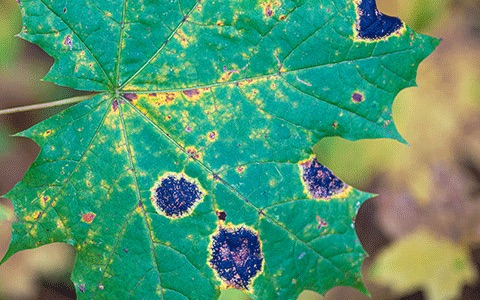
NOTE: Sanitize all equipment, including gloves and protective clothing that come in contact with an infected tree and its foliage.
Anthracnose (Aureobasidium apocryptum or Discula – Gloeosporium) – Anthracnose is a fungal infection that causes purple or brown streaks to occur alongside and between leaf veins. In some maple species, drought and heat stress can produce similar symptoms. You can confirm an anthracnose infection by locating small, brown fungal fruiting structures near the veins of affected leaves.
Treatment: The same measures and precautions for leaf spot should be used in the treatment of anthracnose.
NOTE: Anthracnose can lead to severe defoliation during a wet spring season.
Root Rot (Fomes fomentarius, Ganoderma lucidum, or Laetiporus sulfureus) – Once a fungal infection embeds itself in the trunk or the roots of a maple tree, there are three types of symptoms to watch for:
• Foliage in the entire crown or a section of it may suffer from chlorosis, wilt, die and eventually fall. This happens as the fungi cause hydraulic failure within the roots, trunk, and branches.
• Fungal fruiting structures (mushroom conks) will appear from late spring to mid-fall. For these structures to form, there must be rotting organic material within the tree.
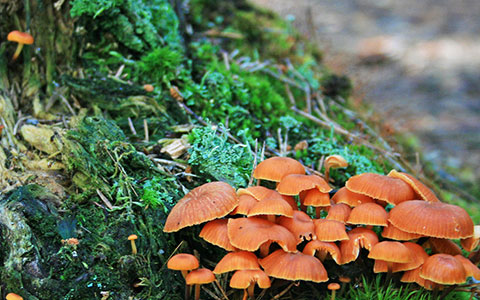
• Large black ants known as carpenter ants will make a nest for their colony within trees that suffer from heart rot. These ants do not burrow through heartwood, they remove the tissues rotting and softened from the infection.
Treatment: Once root rot or heart rot has been confirmed, have the tree professionally removed as quickly as possible.
NOTE: The presence of carpenter ants and fungal fruiting structures only occur after significant damage has been done to the tree. When the affected tree is within striking distance of your home, places where people congregate, or other structures and vehicles, the situation should be treated as an emergency.
Galls – These spots are irregular growths or swellings that occur from a reaction to tissue feeding or egg-laying by various species of mites and insects (commonly mistaken for fungal infection).
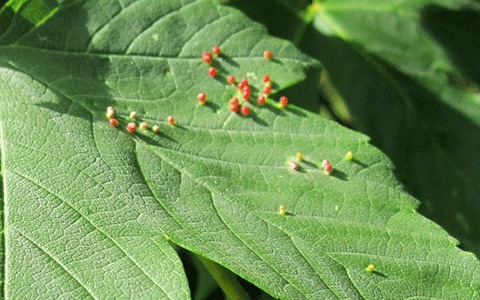
Galls appear in various ways. Each mite or insect species produces a distinctive gall shape and can range from wart-like bumps to felt-like patches to spindle-shaped protrusions. Galls develop in the spring, and once formed, the pest remains protected within the structure. Arborists can often identify which mite or insect has infested your tree by the shape and appearance of the galls.
Treatment: Leaf galls are relatively innocuous and rarely result in any long term damage to the tree. Applications of pesticides are relatively ineffective, as the pests are protected within the gall structure.
The most effective manner of gall removal is to handpick and destroy affected foliage before exit holes form and allow the pest(s) to move on. If the presence of galls is overwhelming, hire a professional tree service to evaluate the situation and recommend a course of action.
Maple Tree Disease Prevention
Maple tree disease prevention begins with good tree care practices. The healthier your tree is, the more vigorously it can fight back against diseases and infestations.
However, when the tree’s defenses fail, here are steps to prevent the disease or infestation from infecting surrounding trees:
• Prune affected limbs (before leaf-drop)
• Burn all pruned limbs and foliage
• Always sanitize pruning equipment after use on an infected tree
• Avoid tracking soil from around infected trees to areas around uninfected trees (many fungi and other pathogens thrive in the soil). Clean boots, protective clothing, tools, and equipment before leaving an infested area
• Replant resistant species after tree removal
• Avoid planting maple trees in areas with a history of tree diseases
• Have annual tree inspections and soil testing performed to detect any issues early on.
Black Spots on Maple Leaves
In this article, you discovered how to identify diseases that cause spots on maple tree leaves, how to treat them, and how to prevent them.
Prevent the decline of your maple tree by knowing what to do when a fungus or pathogen begins showing signs of infection.
Your choice to ignore signs that your tree is diseased or in decline can result in catastrophic fungal outbreaks to your landscape, or costly damages to your property when the tree falls.
Sources:
extension.psu.edu/maple-diseases
hgic.clemson.edu/factsheet/maple-diseases-insect-pests/
pnwhandbooks.org/plantdisease/host-disease/maple-acer-spp-verticillium-wilt
Notice: Undefined variable: page in /home/vrxdg1855sn3/public_html/wp-content/themes/72tree/content.php on line 15
Notice: Trying to get property 'ID' of non-object in /home/vrxdg1855sn3/public_html/wp-content/themes/72tree/content.php on line 15
Who is Responsible for Overhanging Tree Branches
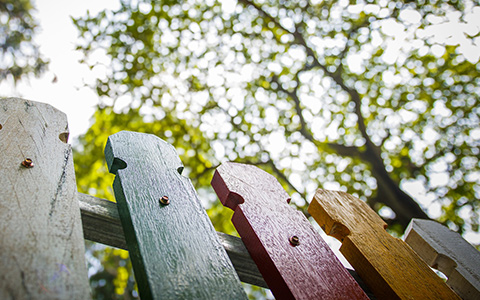
Don’t accept liability for a tree or its overhanging branches without clarifying responsibility. Once you know how to determine responsibility for a tree and its overhanging branches, you can better reach fair solutions with your neighbors during a tree dispute.
72tree.com gathered the following information on determining who owns and is responsible for a tree’s overhanging branches, and what actions to take.
Trees and Your Property Line
Whether you find yourself on the giving or receiving end of an overhanging tree complaint, it is essential to know who owns the tree in question.
When you purchased your property, you were likely required to get a property survey. If many years have elapsed or there is difficulty determining where the property line is, have a new survey conducted with the surveyor physically marking the property line.
All trees growing on your property with their trunks inside your property line are your responsibility.
In the rare case that a tree is growing directly on the property line, ownership and responsibility of that tree are equally shared between you and your neighbor.
Overhanging Tree Branches
As a tree grows upward, it also grows outward. Over time, some of those branches can grow past your property line overhanging your neighbor’s yard or home. The responsibilities of each property owner are typically as follows:
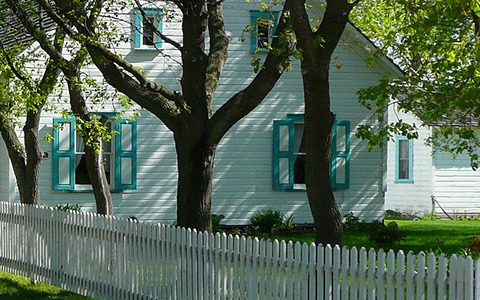
Owner of the Tree – You are responsible for the overall care of the tree, including:
• Watering, mulching, and fertilizing
• Staking or anchoring if the tree becomes unstable or is leaning
• Trimming or pruning the canopy (up to your property line)
• Detecting and treating illnesses and insect infestations. Learn more about tree health problems and solutions at 72tree.com/9-common-tree-health-problems-solutions/
If your tree succumbs to disease, infestation, or dies for any reason, the responsibility to remove the tree is yours. You could be held responsible for the damages it may cause if it should fall.
The Neighbor – Your neighbor is responsible for the following:
• The trimming or pruning of overhanging branches up to their property line*
• Cleaning fallen leaves, needles, twigs and other debris from the overhanging branches
Your neighbor should also make any concerns or complaints about potential hazards from the tree known to you.
If your neighbor documents this communication or files a complaint with the town, and you do nothing, you may be held liable for damages caused by any portion of the tree falling on your neighbor’s property.
*All trimming or pruning activities must be done in a way that promotes the health of the tree. If your neighbor’s actions result in the declining health or death of the tree, they may be held liable for the cost of the replacement of that tree.
Your Tree Falls on Your Neighbor’s Property
If your tree or a portion of the tree should fall on your neighbor’s property, the health of the tree when it fell is vital in determining responsibility.
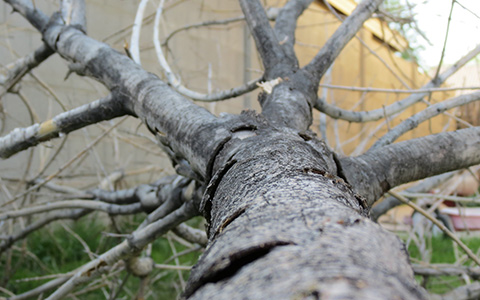
Healthy Tree – If the tree was healthy and well maintained with no signs of decay or infestation, the removal and any damages caused by the tree will be your neighbor’s responsibility.
The majority of homeowners insurance providers will cover such a claim.
Diseased or Dying Tree – If your tree had clear signs of disease, infestation, rot, or your neighbor filed a complaint about the hazard, you could be held liable for all damages caused by the falling tree.
Protect yourself and your neighbors by hiring a trusted tree service to perform annual inspections of your trees. These inspections allow them to detect any potential trouble and recommend a course of action.
Learn more about what to do when a neighbor’s tree falls on your house at 72tree.com/my-neighbors-tree-fell-on-my-house-now-what/
View Obstruction Ordinances
Throughout the United States, there are a few cities with “view ordinances.” These ordinances state the importance of the view to the value of the property.
If your tree reaches a height that obstructs a neighbor’s view (in a city with such ordinances), you may be ordered to reduce the height of the tree or remove it.
Before planting new trees on your property, it is worth the time and effort to research your city’s laws for these specific ordinances. Once you know the limitations imposed by these ordinances, you can select the appropriate species to plant.
Overhanging Tree Responsibility
In this article, you discovered how tree ownership is determined, what you are responsible for when trees overhang a neighbor’s property, and their responsibilities.
By properly caring for your trees and having them inspected annually, you can detect potential issues early and get them resolved before turning into a problem or dispute.
If you choose to neglect the health of your tree(s), you can be held liable for all damages caused by that tree falling on your neighbor’s property or house.
NOTE: Cities, municipalities, and towns have ordinances that may vary from the information presented in this article. It is always recommended that you search for your city’s tree ordinances to fully inform yourself.
Sources:
http://agrisk.umd.edu/blog/frequently-asked-questions-can-i-cut-my-neighbors-tree-back-from-our-property-line
hg.org/legal-articles/neighbor-s-right-to-build-36677
extension.tennessee.edu/publications/Documents/SP687.pdf
secure.caes.uga.edu/extension/publications/files/pdf/C%201099_1.PDF
Notice: Undefined variable: page in /home/vrxdg1855sn3/public_html/wp-content/themes/72tree/content.php on line 15
Notice: Trying to get property 'ID' of non-object in /home/vrxdg1855sn3/public_html/wp-content/themes/72tree/content.php on line 15
A Beginners Guide to Tree Planting
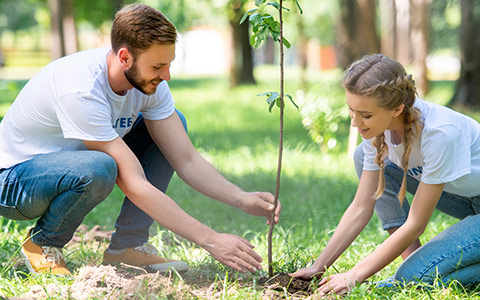
Your tree is more likely to die if you don’t consider the factors that affect its development during their planting. Your trees’ health is directly correlated to the time, location, pre-planning, and species that you choose ever before planting.
72tree.com assembled the following guide with professional tips to help you properly plant and care for your tree.
Best Time to Plant Trees
There is much debate as to when the best tree planting time is. For more moderate climates such as the south, southeast, or southwest, either early fall or early spring are appropriate planting times.
For locations where there is winter snow cover or ground freeze, spring (after the ground thaws) is the best time to plant.
Tree Location
Now that you’ve decided to plant a tree and identified the best time, you’ll need to choose a suitable location. In doing so, take the following factors into consideration:
Sunlight – Does the planting location get full sun (all day), partial sun (morning or evening), or full shade (no sun)
Water – Most tree species require well-drained soil. If your chosen location is in a low-lying area or a depression, water may accumulate and stand, leading to root rot and other diseases.
Tip: Verify that your location is well-drained after a rainstorm or run a hose at the site to see how the water accumulates or runs off.
Soil – The soil where you plant your tree should be loose, mixed with organic material, and turned to avoid compaction.
Tip: Many tree species can thrive in a soil pH level between 5 (acidic) and 7(neutral). You can raise the soil pH by adding lime or limestone and reduce the pH by adding aluminum sulfate, sulfur, manure, or compost (pH levels above 7 are alkaline).
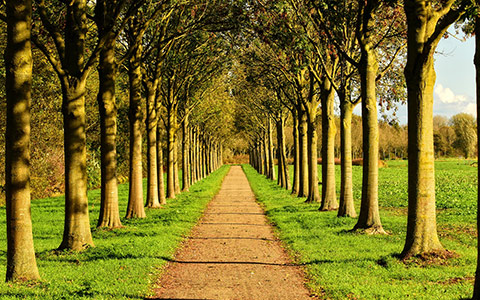
Spacing – When planting multiple trees, they can be spaced apart according to their mature canopy spread. Tree spacings from 20 to 60 feet apart are standard. This spacing allows the open-grown form of the tree canopy to develop naturally.
Conversely, when planted too close together, a tree may fail to reach its mature height and struggle to absorb enough sunlight and nutrients to remain healthy.
Tip: Follow spacing recommendations for your specific tree species.
Wind – The location you’ve selected should be observed over time to determine whether or not your tree will endure constant wind or violent wind gusts.
Tip: Stake young trees until they can support themselves without bending under pressure. Most trees will take one to two years before fully establishing their root systems.
Structures – A tree’s roots spread far from where it is planted. As roots spread, they thicken and may become invasive. When a tree is planted too close to a house, sidewalk, patio, or driveway, those roots can grow underneath the structure and break up or buckle the concrete.
Tip: Plant trees far from structures with concrete foundations or slabs, and install root barriers to protect building foundations, driveways, sidewalks, etc.
Protection – Weather and wildlife can stress or kill your tree as it matures. By planting shrubs near and around your tree, you can naturally lessen the impact of wind. Surrounding structures will also act in this capacity.
Tip: Discourage wildlife from grazing your tree’s foliage or damaging its bark by putting up chicken wire around the tree, using bark wraps, or by using chemical deterrents.
The USDA Plant Hardiness Zone Map defines planting zones from 1a to 13b. The zone in which you plan to plant a tree will determine which species you should select. You can determine your hardiness zone at planthardiness.ars.usda.gov/PHZMWeb/InteractiveMap.aspx
Tree Species
The species of tree you decide to plant can profoundly impact the surrounding landscape in various ways. Verify that the species you intend to plant is appropriate for the location in which you are planting and consider the following:
Deciduous or Evergreen Trees – If you want your tree to maintain a lush green appearance year-round, you are looking for an evergreen species which may include:
• Blue Spruce
• Scots Pine
• Green Giant Arborvitae
• Magnolia
• Holly
• Leyland Cypress
If you want to enjoy fall colors as your tree prepares to go dormant for the winter, you are looking for one of the many deciduous species which may include:
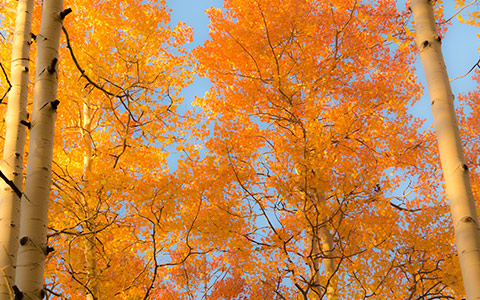
• Oaks
• Maples
• Birch
• Sweetgum
• Tulip
• Quaking Aspen
Tip: Regarding quaking aspens, the species has an invasive root system and will produce suckers that are clones of the original tree. When planting this species, be sure that it has enough space to grow and spread without obstruction.
Understory or Overstory – An understory tree may be best if your planting location is restricted or you desire a mid-sized tree. The following species are considered understory, and are shade tolerant reaching mature heights of 20 to 40 feet:
• Flowering Dogwood
• Eastern Redbud
• White Fringetree
• Japanese Maple
• Black Aldar
If you are looking for a tree that makes a statement by its size and you have the landscape to accommodate its growth, the following overstory species reach mature heights of 60 to over 100 feet:
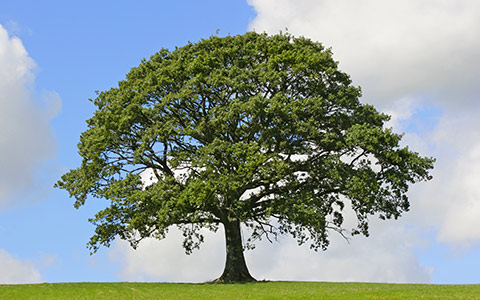
• Southern Magnolia
• Green Ash
• White Oak
• Southern Red Oak
Tip: When planting multiple trees, understory trees can be planted near overstory trees as protection from strong or persistent winds.
For more info, refer to 72tree.com/tree-buying-tips/ before purchasing the trees you intend to plant.
Planting Your Tree
When planting a seedling or sapling, the following should be considered in the preparation of the planting location:
Surrounding Soil – Organic material or pH stabilizing material should be mixed into the soil in no less than a 2-foot radius of where the tree will be planted.
Tip: When transplanting a more developed tree, treat the soil in a 3 to 4-foot radius of the planting location.
Dig the Hole – Measure the distance from the bottom of the trunk to the bottom of the roots or root ball; this is how deep your hole must be. The hole must also be wide enough for the entire root ball to fit without being cramped or bent.
Tip: To confirm the accuracy of the depth, allow the tree to rest in the hole paying particular attention to where the roots connect to the tree. Known as the root flare, it should remain just above the ground.
Water in the Hole – Before planting your tree, provide a deep watering for the hole, allowing water to soak deep into the earth below. This moisture will encourage roots to grow deep.
Plant the Tree – Now that your hole is dug, the soil enriched, and the ground watered, place your tree in the hole covering the roots with soil up to the root flare.
Tip: When covering the roots with soil, do not overly compact it. Water the newly planted tree and allow the soil to settle. As the soil settles, add more to the top, keeping the root flare just above ground level.
Watering – Your newly planted tree should receive a deep watering 2 to 3 times per week. Avoid shallow waterings as they encourage roots to grow to the surface.
Tip: Use a slow-release watering system which maintains constant moisture while allowing proper drainage for excess water.
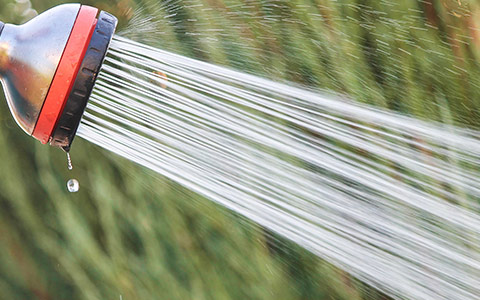
During rainy seasons, scale back the watering schedule and increase it during periods of drought. Don’t allow the soil to dry out for newly planted trees completely.
Fertilizer – If you have prepared the soil in and around the planting location, no fertilizing should be necessary for the first full year of growth.
Tip: Use organic mulch around the tree. As it decays, mulch releases nutrients into the soil. An added advantage is that mulch helps the soil retain moisture and warmth, both of which are fundamental for healthy root growth.
Tree Planting and Your Landscape
Your tree is likely to struggle and die without considering the factors that influence its growth when it is planted.
In this article, you discovered how to determine the correct tree species for your landscape, how to prepare the planting location, and pro tips to help you avoid common mistakes when planting a tree.
Your lack of knowledge about soil, sun, water, location, and species when planting a tree can result in its declining health and eventual death.
Sources:
extension.umn.edu/planting-and-growing-guides/watering-newly-planted-trees-and-shrubs
static.colostate.edu/client-files/csfs/pdfs/TreePlanting_636.pdf
extension.umn.edu/trees-and-shrubs/choosing-evergreens-your-landscape
